Assessment 2: Literature Review on Titanium Alloys in Biomedicine
VerifiedAdded on 2023/01/17
|7
|1572
|85
Literature Review
AI Summary
This literature review explores the indispensable role of titanium alloys in biomedicine, emphasizing their crucial physical and chemical attributes like elasticity, biocompatibility, and low density. The review systematically analyzes the application of titanium alloys in engineering projects, focusing on integration initiatives and design-based learning. It highlights the alloys' excellent features, making them unique and essential for researchers and medical practitioners. The review also examines the alloy's application in preventing bone resorption, promoting bone remodeling, and preventing stress shielding. The review also covers the application of titanium alloys in airplanes, rockets, and missiles. The paper also discusses the importance of biocompatibility and corrosion resistance, making it a crucial material in the field of medicine. The literature review also discusses the theoretical perspectives of design-based learning and authentic engineering design techniques, showcasing the alloy's versatility and importance in various engineering fields.
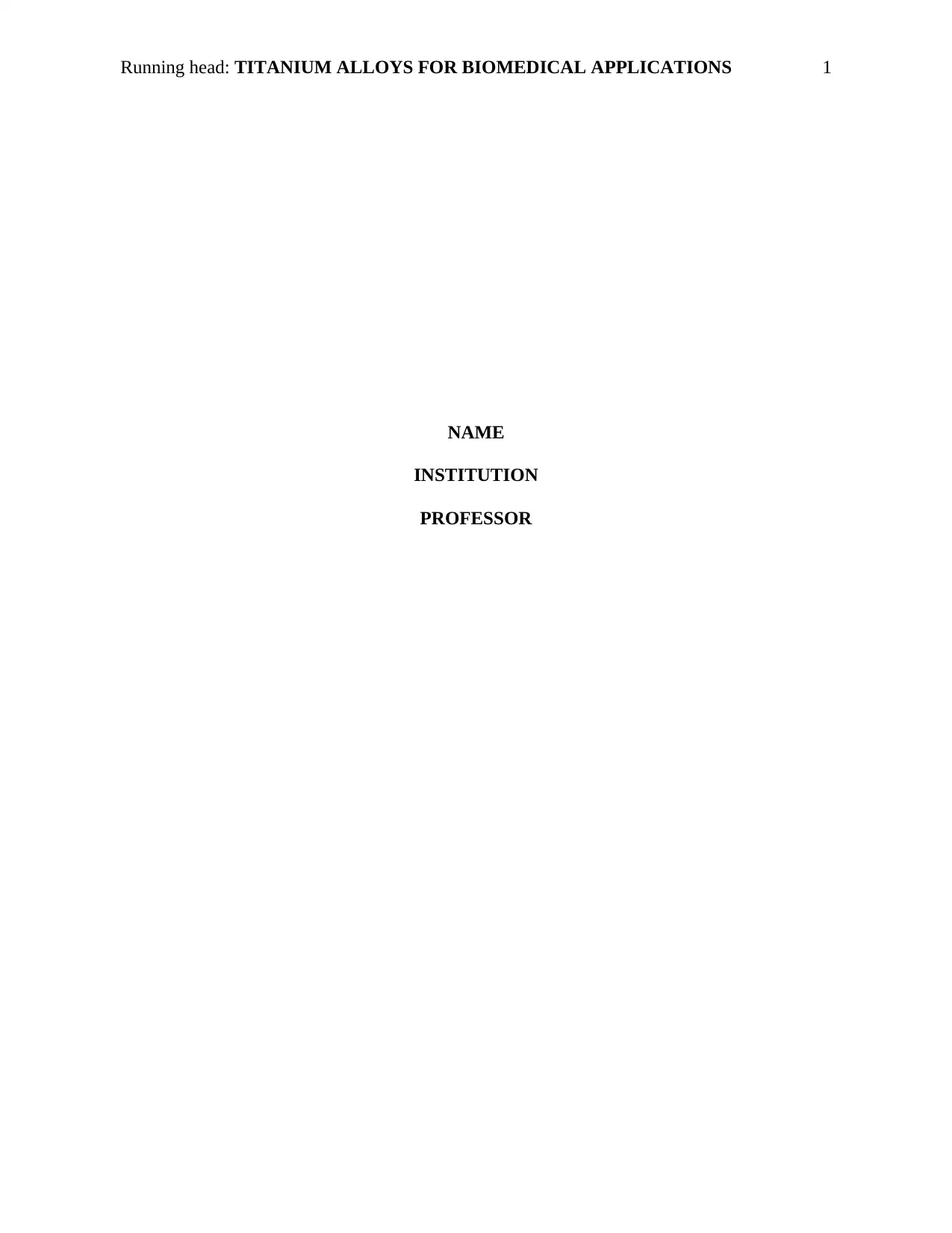
Running head: TITANIUM ALLOYS FOR BIOMEDICAL APPLICATIONS 1
NAME
INSTITUTION
PROFESSOR
NAME
INSTITUTION
PROFESSOR
Paraphrase This Document
Need a fresh take? Get an instant paraphrase of this document with our AI Paraphraser
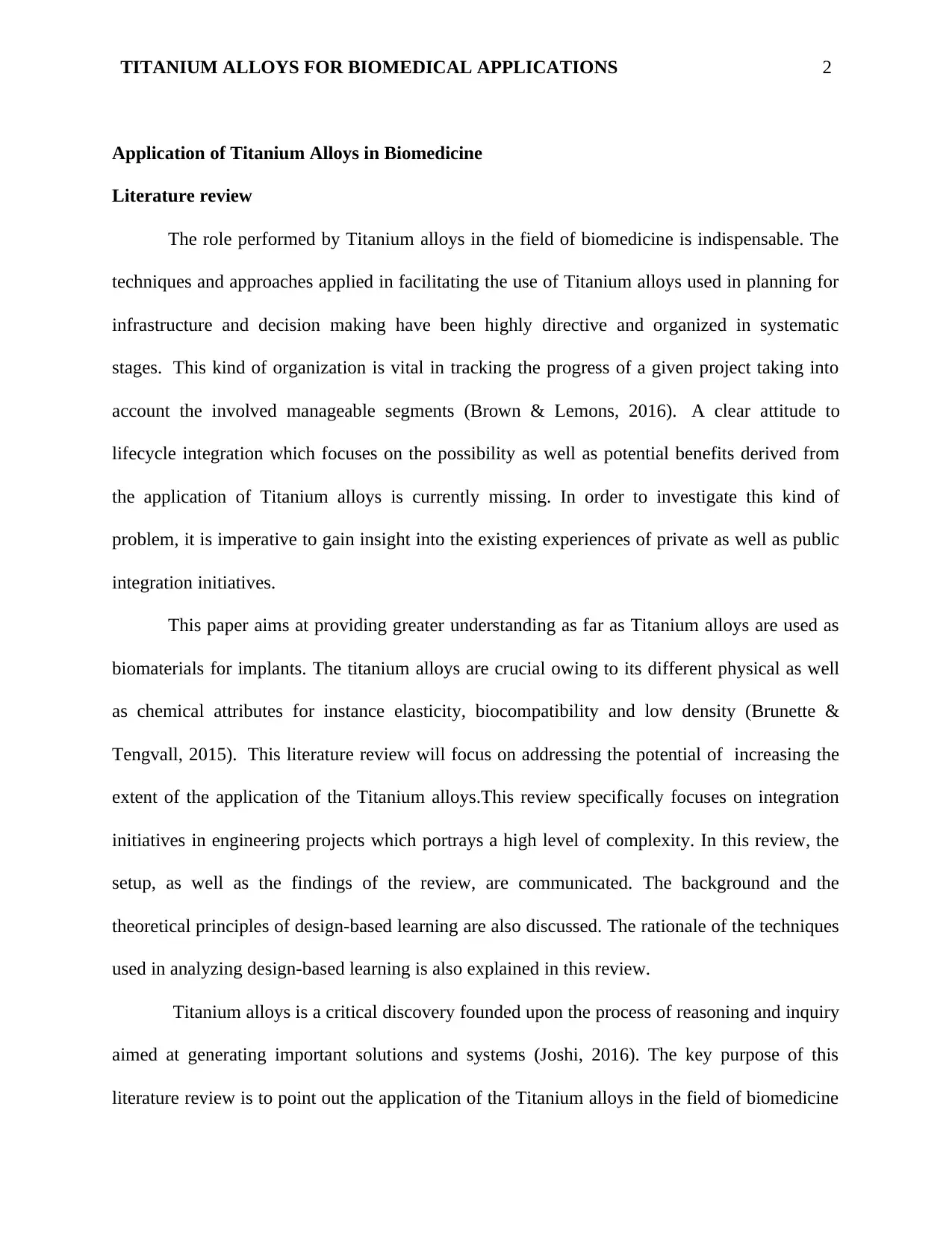
TITANIUM ALLOYS FOR BIOMEDICAL APPLICATIONS 2
Application of Titanium Alloys in Biomedicine
Literature review
The role performed by Titanium alloys in the field of biomedicine is indispensable. The
techniques and approaches applied in facilitating the use of Titanium alloys used in planning for
infrastructure and decision making have been highly directive and organized in systematic
stages. This kind of organization is vital in tracking the progress of a given project taking into
account the involved manageable segments (Brown & Lemons, 2016). A clear attitude to
lifecycle integration which focuses on the possibility as well as potential benefits derived from
the application of Titanium alloys is currently missing. In order to investigate this kind of
problem, it is imperative to gain insight into the existing experiences of private as well as public
integration initiatives.
This paper aims at providing greater understanding as far as Titanium alloys are used as
biomaterials for implants. The titanium alloys are crucial owing to its different physical as well
as chemical attributes for instance elasticity, biocompatibility and low density (Brunette &
Tengvall, 2015). This literature review will focus on addressing the potential of increasing the
extent of the application of the Titanium alloys.This review specifically focuses on integration
initiatives in engineering projects which portrays a high level of complexity. In this review, the
setup, as well as the findings of the review, are communicated. The background and the
theoretical principles of design-based learning are also discussed. The rationale of the techniques
used in analyzing design-based learning is also explained in this review.
Titanium alloys is a critical discovery founded upon the process of reasoning and inquiry
aimed at generating important solutions and systems (Joshi, 2016). The key purpose of this
literature review is to point out the application of the Titanium alloys in the field of biomedicine
Application of Titanium Alloys in Biomedicine
Literature review
The role performed by Titanium alloys in the field of biomedicine is indispensable. The
techniques and approaches applied in facilitating the use of Titanium alloys used in planning for
infrastructure and decision making have been highly directive and organized in systematic
stages. This kind of organization is vital in tracking the progress of a given project taking into
account the involved manageable segments (Brown & Lemons, 2016). A clear attitude to
lifecycle integration which focuses on the possibility as well as potential benefits derived from
the application of Titanium alloys is currently missing. In order to investigate this kind of
problem, it is imperative to gain insight into the existing experiences of private as well as public
integration initiatives.
This paper aims at providing greater understanding as far as Titanium alloys are used as
biomaterials for implants. The titanium alloys are crucial owing to its different physical as well
as chemical attributes for instance elasticity, biocompatibility and low density (Brunette &
Tengvall, 2015). This literature review will focus on addressing the potential of increasing the
extent of the application of the Titanium alloys.This review specifically focuses on integration
initiatives in engineering projects which portrays a high level of complexity. In this review, the
setup, as well as the findings of the review, are communicated. The background and the
theoretical principles of design-based learning are also discussed. The rationale of the techniques
used in analyzing design-based learning is also explained in this review.
Titanium alloys is a critical discovery founded upon the process of reasoning and inquiry
aimed at generating important solutions and systems (Joshi, 2016). The key purpose of this
literature review is to point out the application of the Titanium alloys in the field of biomedicine
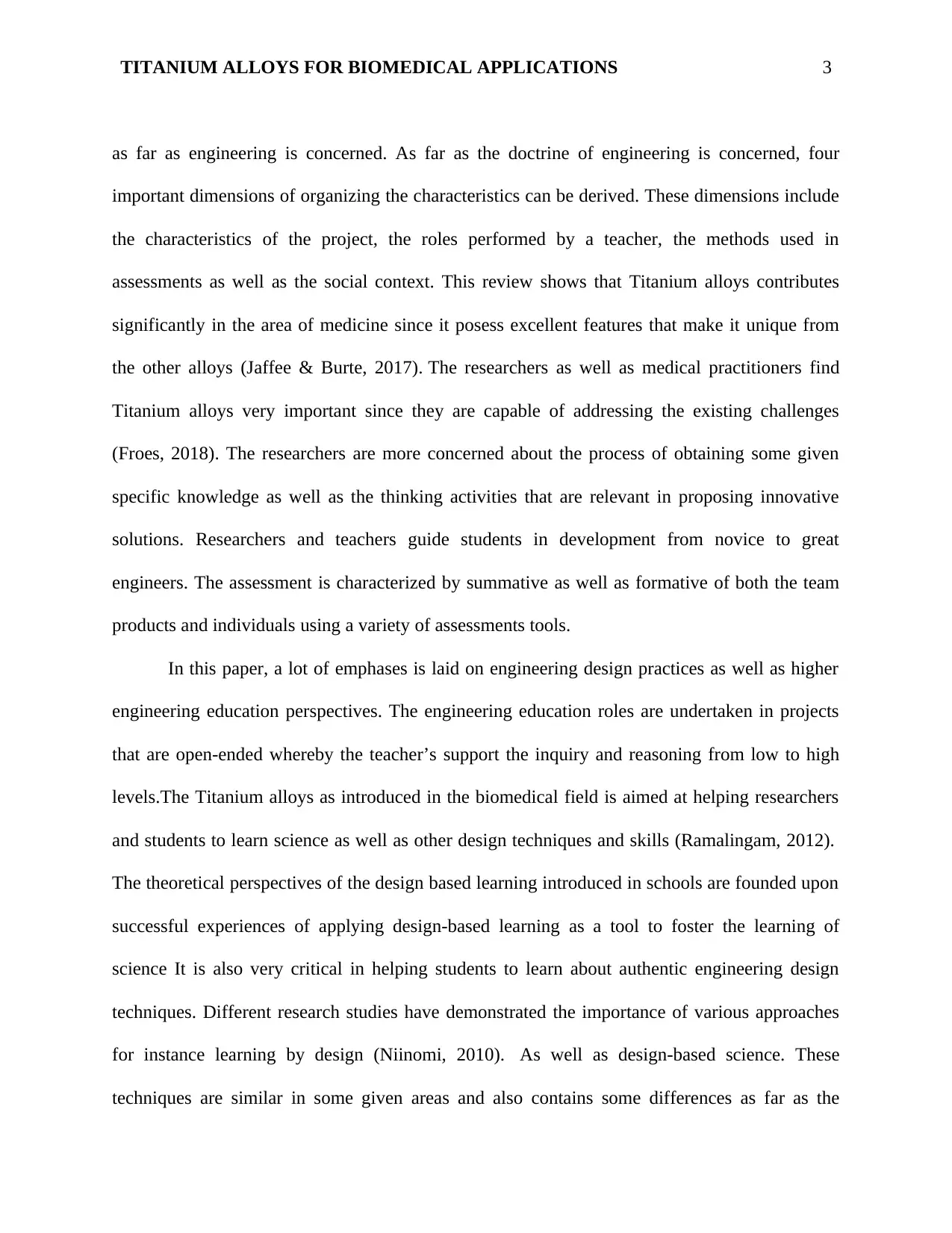
TITANIUM ALLOYS FOR BIOMEDICAL APPLICATIONS 3
as far as engineering is concerned. As far as the doctrine of engineering is concerned, four
important dimensions of organizing the characteristics can be derived. These dimensions include
the characteristics of the project, the roles performed by a teacher, the methods used in
assessments as well as the social context. This review shows that Titanium alloys contributes
significantly in the area of medicine since it posess excellent features that make it unique from
the other alloys (Jaffee & Burte, 2017). The researchers as well as medical practitioners find
Titanium alloys very important since they are capable of addressing the existing challenges
(Froes, 2018). The researchers are more concerned about the process of obtaining some given
specific knowledge as well as the thinking activities that are relevant in proposing innovative
solutions. Researchers and teachers guide students in development from novice to great
engineers. The assessment is characterized by summative as well as formative of both the team
products and individuals using a variety of assessments tools.
In this paper, a lot of emphases is laid on engineering design practices as well as higher
engineering education perspectives. The engineering education roles are undertaken in projects
that are open-ended whereby the teacher’s support the inquiry and reasoning from low to high
levels.The Titanium alloys as introduced in the biomedical field is aimed at helping researchers
and students to learn science as well as other design techniques and skills (Ramalingam, 2012).
The theoretical perspectives of the design based learning introduced in schools are founded upon
successful experiences of applying design-based learning as a tool to foster the learning of
science It is also very critical in helping students to learn about authentic engineering design
techniques. Different research studies have demonstrated the importance of various approaches
for instance learning by design (Niinomi, 2010). As well as design-based science. These
techniques are similar in some given areas and also contains some differences as far as the
as far as engineering is concerned. As far as the doctrine of engineering is concerned, four
important dimensions of organizing the characteristics can be derived. These dimensions include
the characteristics of the project, the roles performed by a teacher, the methods used in
assessments as well as the social context. This review shows that Titanium alloys contributes
significantly in the area of medicine since it posess excellent features that make it unique from
the other alloys (Jaffee & Burte, 2017). The researchers as well as medical practitioners find
Titanium alloys very important since they are capable of addressing the existing challenges
(Froes, 2018). The researchers are more concerned about the process of obtaining some given
specific knowledge as well as the thinking activities that are relevant in proposing innovative
solutions. Researchers and teachers guide students in development from novice to great
engineers. The assessment is characterized by summative as well as formative of both the team
products and individuals using a variety of assessments tools.
In this paper, a lot of emphases is laid on engineering design practices as well as higher
engineering education perspectives. The engineering education roles are undertaken in projects
that are open-ended whereby the teacher’s support the inquiry and reasoning from low to high
levels.The Titanium alloys as introduced in the biomedical field is aimed at helping researchers
and students to learn science as well as other design techniques and skills (Ramalingam, 2012).
The theoretical perspectives of the design based learning introduced in schools are founded upon
successful experiences of applying design-based learning as a tool to foster the learning of
science It is also very critical in helping students to learn about authentic engineering design
techniques. Different research studies have demonstrated the importance of various approaches
for instance learning by design (Niinomi, 2010). As well as design-based science. These
techniques are similar in some given areas and also contains some differences as far as the
⊘ This is a preview!⊘
Do you want full access?
Subscribe today to unlock all pages.

Trusted by 1+ million students worldwide
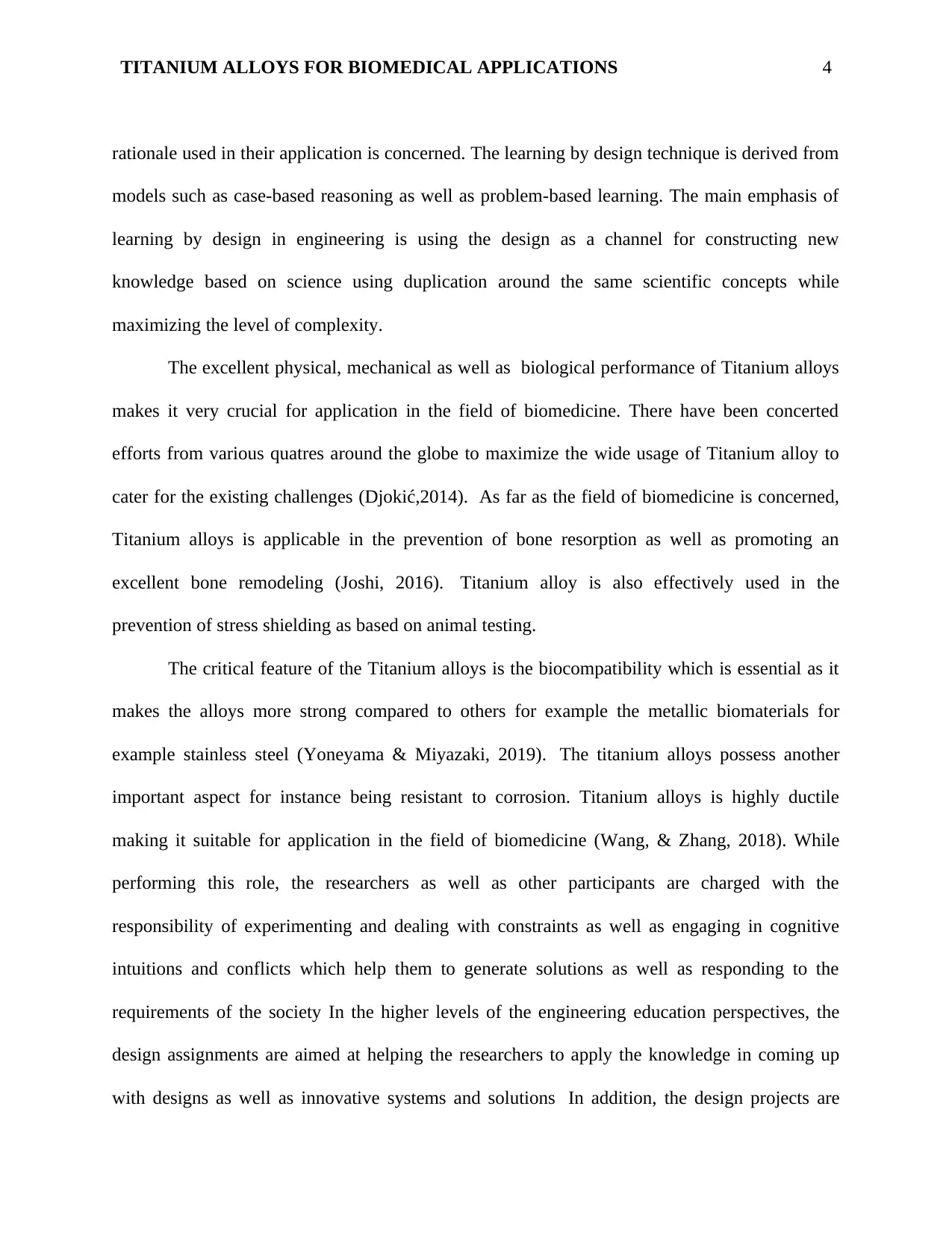
TITANIUM ALLOYS FOR BIOMEDICAL APPLICATIONS 4
rationale used in their application is concerned. The learning by design technique is derived from
models such as case-based reasoning as well as problem-based learning. The main emphasis of
learning by design in engineering is using the design as a channel for constructing new
knowledge based on science using duplication around the same scientific concepts while
maximizing the level of complexity.
The excellent physical, mechanical as well as biological performance of Titanium alloys
makes it very crucial for application in the field of biomedicine. There have been concerted
efforts from various quatres around the globe to maximize the wide usage of Titanium alloy to
cater for the existing challenges (Djokić,2014). As far as the field of biomedicine is concerned,
Titanium alloys is applicable in the prevention of bone resorption as well as promoting an
excellent bone remodeling (Joshi, 2016). Titanium alloy is also effectively used in the
prevention of stress shielding as based on animal testing.
The critical feature of the Titanium alloys is the biocompatibility which is essential as it
makes the alloys more strong compared to others for example the metallic biomaterials for
example stainless steel (Yoneyama & Miyazaki, 2019). The titanium alloys possess another
important aspect for instance being resistant to corrosion. Titanium alloys is highly ductile
making it suitable for application in the field of biomedicine (Wang, & Zhang, 2018). While
performing this role, the researchers as well as other participants are charged with the
responsibility of experimenting and dealing with constraints as well as engaging in cognitive
intuitions and conflicts which help them to generate solutions as well as responding to the
requirements of the society In the higher levels of the engineering education perspectives, the
design assignments are aimed at helping the researchers to apply the knowledge in coming up
with designs as well as innovative systems and solutions In addition, the design projects are
rationale used in their application is concerned. The learning by design technique is derived from
models such as case-based reasoning as well as problem-based learning. The main emphasis of
learning by design in engineering is using the design as a channel for constructing new
knowledge based on science using duplication around the same scientific concepts while
maximizing the level of complexity.
The excellent physical, mechanical as well as biological performance of Titanium alloys
makes it very crucial for application in the field of biomedicine. There have been concerted
efforts from various quatres around the globe to maximize the wide usage of Titanium alloy to
cater for the existing challenges (Djokić,2014). As far as the field of biomedicine is concerned,
Titanium alloys is applicable in the prevention of bone resorption as well as promoting an
excellent bone remodeling (Joshi, 2016). Titanium alloy is also effectively used in the
prevention of stress shielding as based on animal testing.
The critical feature of the Titanium alloys is the biocompatibility which is essential as it
makes the alloys more strong compared to others for example the metallic biomaterials for
example stainless steel (Yoneyama & Miyazaki, 2019). The titanium alloys possess another
important aspect for instance being resistant to corrosion. Titanium alloys is highly ductile
making it suitable for application in the field of biomedicine (Wang, & Zhang, 2018). While
performing this role, the researchers as well as other participants are charged with the
responsibility of experimenting and dealing with constraints as well as engaging in cognitive
intuitions and conflicts which help them to generate solutions as well as responding to the
requirements of the society In the higher levels of the engineering education perspectives, the
design assignments are aimed at helping the researchers to apply the knowledge in coming up
with designs as well as innovative systems and solutions In addition, the design projects are
Paraphrase This Document
Need a fresh take? Get an instant paraphrase of this document with our AI Paraphraser
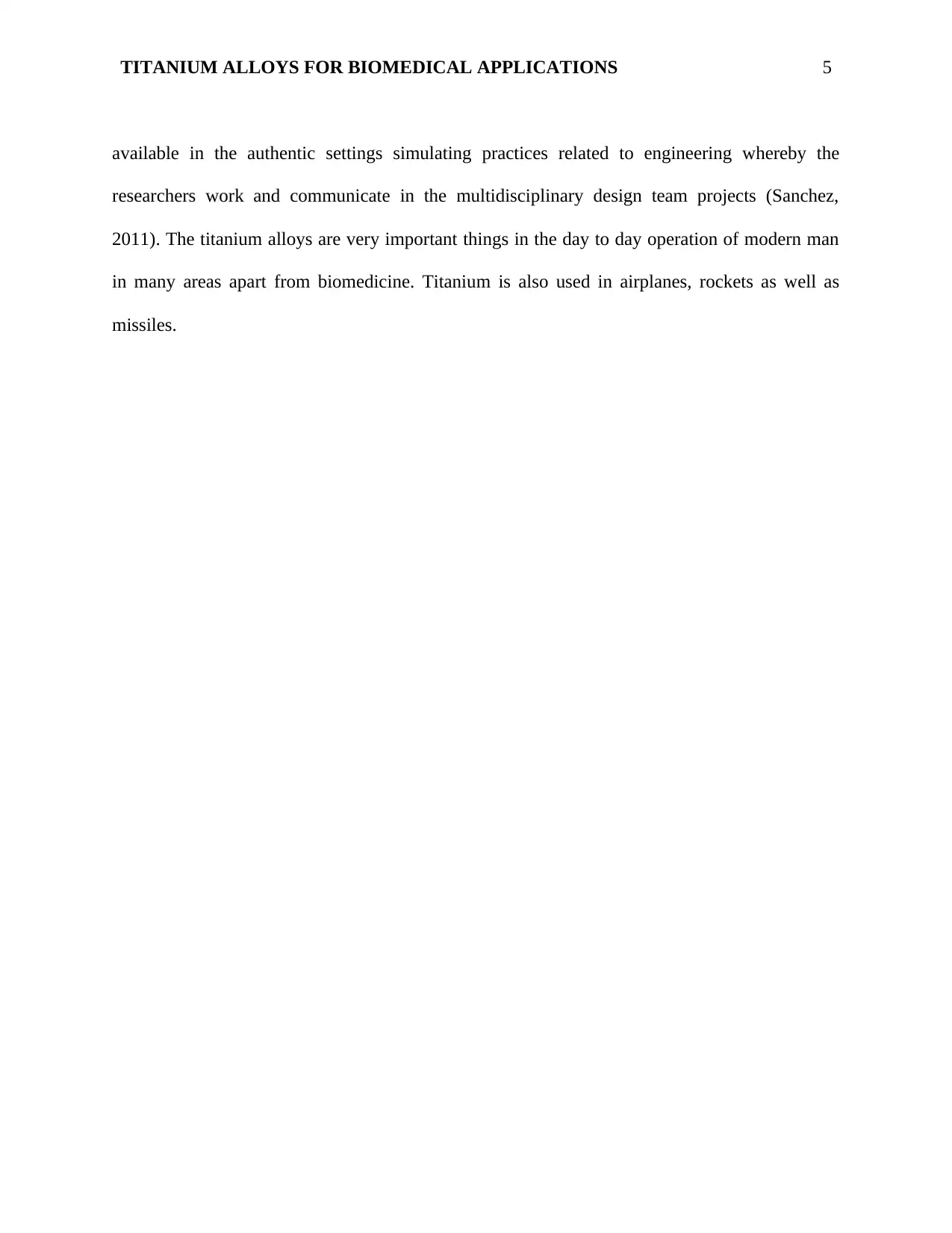
TITANIUM ALLOYS FOR BIOMEDICAL APPLICATIONS 5
available in the authentic settings simulating practices related to engineering whereby the
researchers work and communicate in the multidisciplinary design team projects (Sanchez,
2011). The titanium alloys are very important things in the day to day operation of modern man
in many areas apart from biomedicine. Titanium is also used in airplanes, rockets as well as
missiles.
available in the authentic settings simulating practices related to engineering whereby the
researchers work and communicate in the multidisciplinary design team projects (Sanchez,
2011). The titanium alloys are very important things in the day to day operation of modern man
in many areas apart from biomedicine. Titanium is also used in airplanes, rockets as well as
missiles.
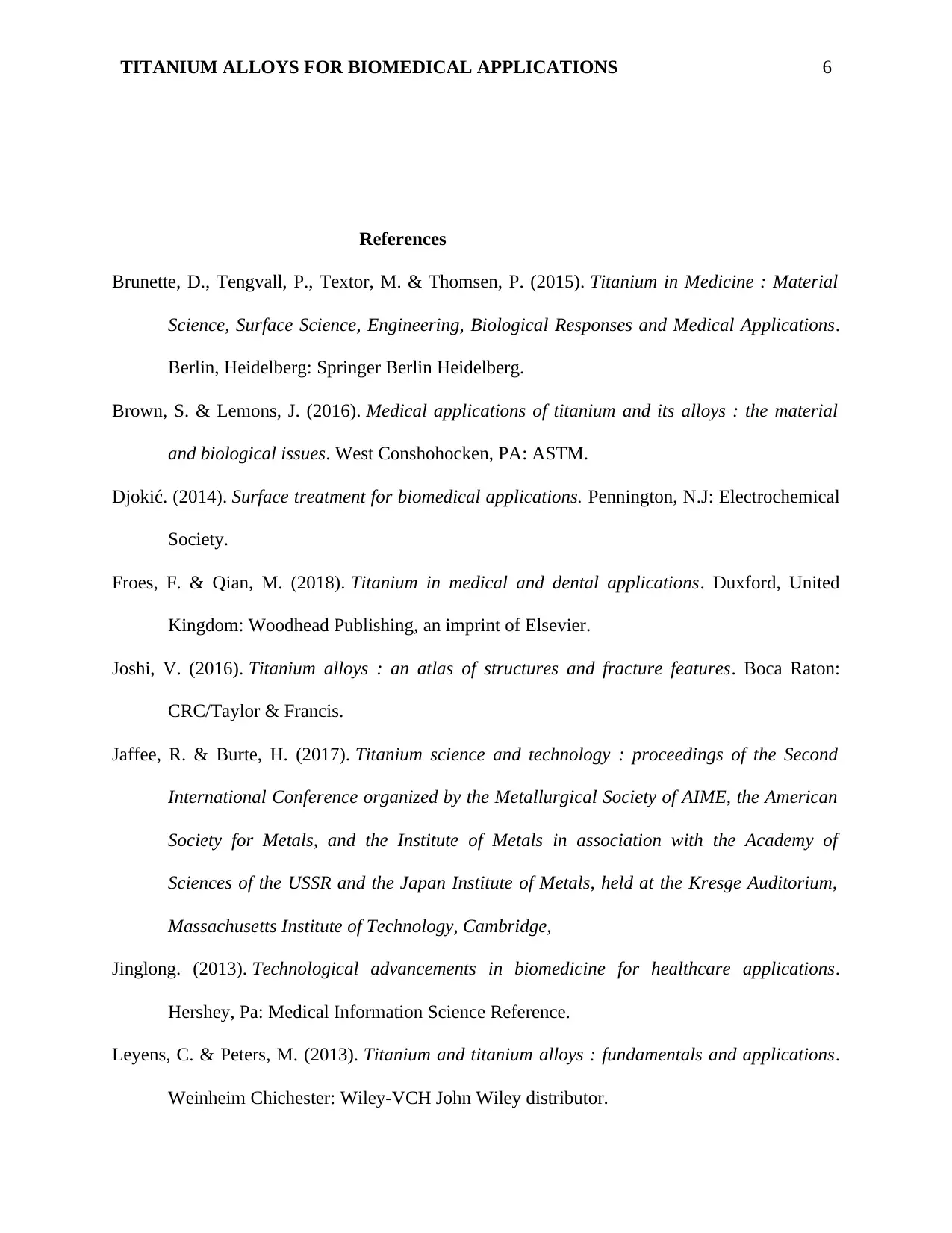
TITANIUM ALLOYS FOR BIOMEDICAL APPLICATIONS 6
References
Brunette, D., Tengvall, P., Textor, M. & Thomsen, P. (2015). Titanium in Medicine : Material
Science, Surface Science, Engineering, Biological Responses and Medical Applications.
Berlin, Heidelberg: Springer Berlin Heidelberg.
Brown, S. & Lemons, J. (2016). Medical applications of titanium and its alloys : the material
and biological issues. West Conshohocken, PA: ASTM.
Djokić. (2014). Surface treatment for biomedical applications. Pennington, N.J: Electrochemical
Society.
Froes, F. & Qian, M. (2018). Titanium in medical and dental applications. Duxford, United
Kingdom: Woodhead Publishing, an imprint of Elsevier.
Joshi, V. (2016). Titanium alloys : an atlas of structures and fracture features. Boca Raton:
CRC/Taylor & Francis.
Jaffee, R. & Burte, H. (2017). Titanium science and technology : proceedings of the Second
International Conference organized by the Metallurgical Society of AIME, the American
Society for Metals, and the Institute of Metals in association with the Academy of
Sciences of the USSR and the Japan Institute of Metals, held at the Kresge Auditorium,
Massachusetts Institute of Technology, Cambridge,
Jinglong. (2013). Technological advancements in biomedicine for healthcare applications.
Hershey, Pa: Medical Information Science Reference.
Leyens, C. & Peters, M. (2013). Titanium and titanium alloys : fundamentals and applications.
Weinheim Chichester: Wiley-VCH John Wiley distributor.
References
Brunette, D., Tengvall, P., Textor, M. & Thomsen, P. (2015). Titanium in Medicine : Material
Science, Surface Science, Engineering, Biological Responses and Medical Applications.
Berlin, Heidelberg: Springer Berlin Heidelberg.
Brown, S. & Lemons, J. (2016). Medical applications of titanium and its alloys : the material
and biological issues. West Conshohocken, PA: ASTM.
Djokić. (2014). Surface treatment for biomedical applications. Pennington, N.J: Electrochemical
Society.
Froes, F. & Qian, M. (2018). Titanium in medical and dental applications. Duxford, United
Kingdom: Woodhead Publishing, an imprint of Elsevier.
Joshi, V. (2016). Titanium alloys : an atlas of structures and fracture features. Boca Raton:
CRC/Taylor & Francis.
Jaffee, R. & Burte, H. (2017). Titanium science and technology : proceedings of the Second
International Conference organized by the Metallurgical Society of AIME, the American
Society for Metals, and the Institute of Metals in association with the Academy of
Sciences of the USSR and the Japan Institute of Metals, held at the Kresge Auditorium,
Massachusetts Institute of Technology, Cambridge,
Jinglong. (2013). Technological advancements in biomedicine for healthcare applications.
Hershey, Pa: Medical Information Science Reference.
Leyens, C. & Peters, M. (2013). Titanium and titanium alloys : fundamentals and applications.
Weinheim Chichester: Wiley-VCH John Wiley distributor.
⊘ This is a preview!⊘
Do you want full access?
Subscribe today to unlock all pages.

Trusted by 1+ million students worldwide
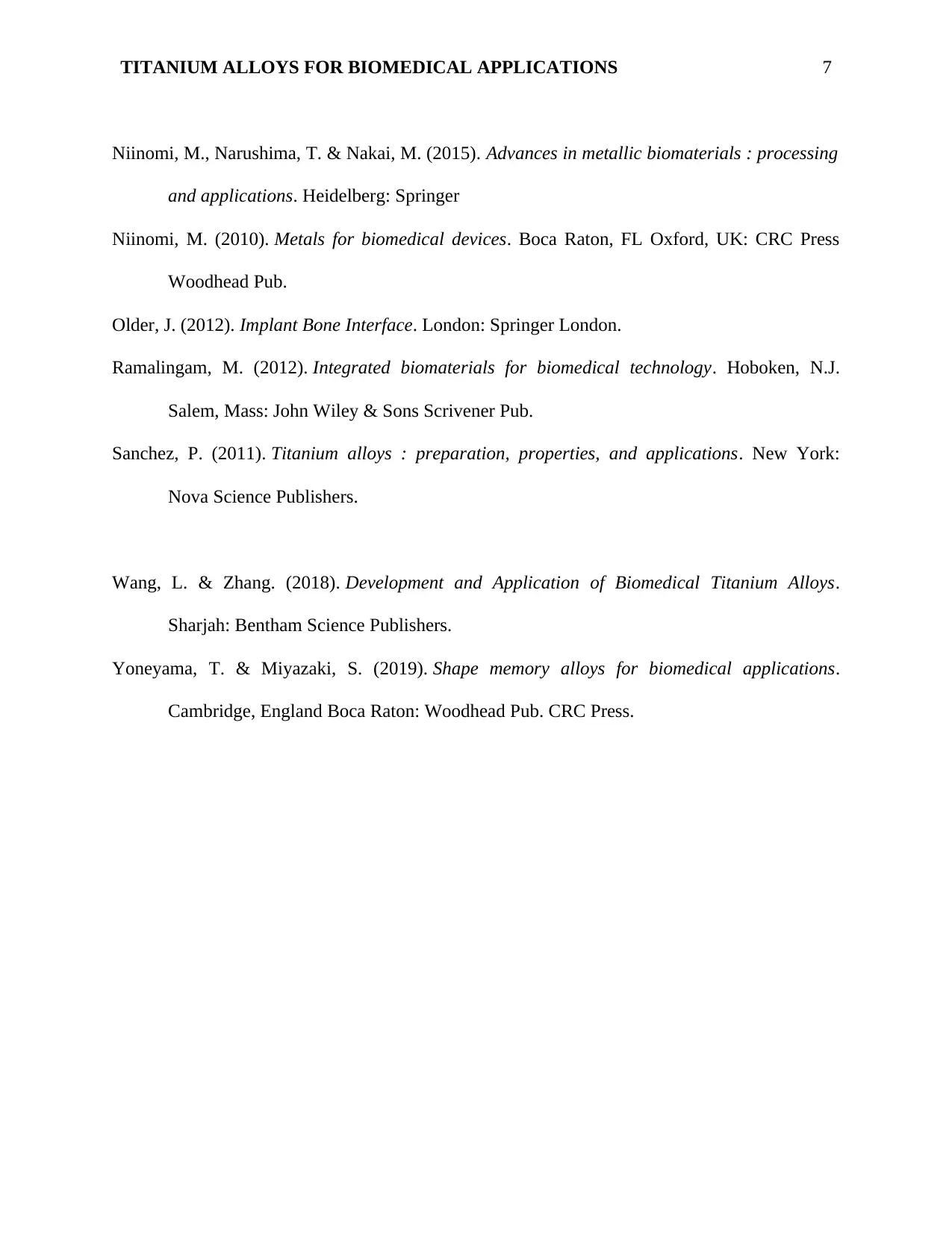
TITANIUM ALLOYS FOR BIOMEDICAL APPLICATIONS 7
Niinomi, M., Narushima, T. & Nakai, M. (2015). Advances in metallic biomaterials : processing
and applications. Heidelberg: Springer
Niinomi, M. (2010). Metals for biomedical devices. Boca Raton, FL Oxford, UK: CRC Press
Woodhead Pub.
Older, J. (2012). Implant Bone Interface. London: Springer London.
Ramalingam, M. (2012). Integrated biomaterials for biomedical technology. Hoboken, N.J.
Salem, Mass: John Wiley & Sons Scrivener Pub.
Sanchez, P. (2011). Titanium alloys : preparation, properties, and applications. New York:
Nova Science Publishers.
Wang, L. & Zhang. (2018). Development and Application of Biomedical Titanium Alloys.
Sharjah: Bentham Science Publishers.
Yoneyama, T. & Miyazaki, S. (2019). Shape memory alloys for biomedical applications.
Cambridge, England Boca Raton: Woodhead Pub. CRC Press.
Niinomi, M., Narushima, T. & Nakai, M. (2015). Advances in metallic biomaterials : processing
and applications. Heidelberg: Springer
Niinomi, M. (2010). Metals for biomedical devices. Boca Raton, FL Oxford, UK: CRC Press
Woodhead Pub.
Older, J. (2012). Implant Bone Interface. London: Springer London.
Ramalingam, M. (2012). Integrated biomaterials for biomedical technology. Hoboken, N.J.
Salem, Mass: John Wiley & Sons Scrivener Pub.
Sanchez, P. (2011). Titanium alloys : preparation, properties, and applications. New York:
Nova Science Publishers.
Wang, L. & Zhang. (2018). Development and Application of Biomedical Titanium Alloys.
Sharjah: Bentham Science Publishers.
Yoneyama, T. & Miyazaki, S. (2019). Shape memory alloys for biomedical applications.
Cambridge, England Boca Raton: Woodhead Pub. CRC Press.
1 out of 7
Related Documents
Your All-in-One AI-Powered Toolkit for Academic Success.
+13062052269
info@desklib.com
Available 24*7 on WhatsApp / Email
![[object Object]](/_next/static/media/star-bottom.7253800d.svg)
Unlock your academic potential
Copyright © 2020–2025 A2Z Services. All Rights Reserved. Developed and managed by ZUCOL.





